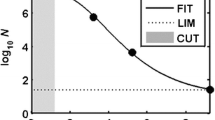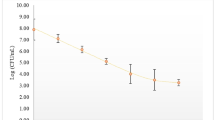Abstract
In order to better understand inactivation of cells during a drying process, the inactivation kinetics of concentrated Lactobacillus paracasei ssp. paracasei (F19) was measured under stationary conditions for different combinations of water activities and temperatures in a water activity range of a w = 0.23–a w = 0.75 and temperatures between 4°C and 50°C. It was shown that the inactivation kinetics of the probiotic bacterium L. paracasei at moderate temperatures could, for all conditions, be formally described by a first-order reaction with activation energies that are much lower than for thermal inactivation (E a = 61 kJ/mol). With regard to the water activity, the reaction rate constants exhibit a maximum inactivation rate at intermediate water activity a w = 0.52. As this behavior has direct implications for the stability of cells in a drying process, the stationary data were used to model the inactivation during test vacuum drying processes, where both temperature and water activity dynamically change. It is shown that—depending on the drying rate—dynamic effects have to be taken into account when modeling the survival during drying. Nevertheless, the model based on stationary inactivation data is capable to predict the characteristics of inactivation during a drying process. Therefore, it can serve as basis to optimize the drying process with regard to maximum survival of cells. However, a further refinement of the model with regard to the drying rate is necessary.





Similar content being viewed by others
References
Ahmad, S., Yaghmaee, P., & Durance, T. (2011). Optimization of dehydration of Lactobacillus salivarius using radiant energy vacuum. Food and Bioprocess Technology. doi:10.1007/s11947-010-0437-y.
Aljarallah, K.-M., & Adams, M.-R. (2007). Mechanisms of heat inactivation in Salmonella serotype Typhimurium as affected by low water activity at different temperatures. Journal of Applied Microbiology, 102, 153–160.
Charteris, W.-P., Kelly, P.-M., Morelli, L., & Collins, J.-K. (1998). Ingredient selection criteria for probiotic microorganisms in functional dairy foods. International Journal of Dairy Technology, 51, 123–136.
Chi Ming, L., Abd Rahim, R., Wan, H.-Y., & Ariff, A.-B. (2009). Formulation of protective agents for improvement of Lactobacillus salivarius I 24 survival rate subjected to freeze drying for production of live cells in powderized form. Food and Bioprocess Technology, 2, 431–436.
Foerst, P., & Kulozik, U. (2009). A low resolution 1H NMR study to investigate the protective mechanism of sorbitol during vacuum drying of a probiotic microorganism. In Guðjónsdóttir, Belton, & Webb (Eds.), Magnetic resonance in food science: challenges in a changing world (pp. 73–80). Cambridge, Great Britain: RSC publishing.
Foerst, P., Reitmaier, J., & Kulozik, U. (2010). 1H NMR investigation on the role of sorbitol for the survival of vacuum dried preparations of L. paracasei ssp. paracasei. Journal of Applied Microbiology, 108, 841–850.
Greenspan, L. (1977). Humidity fixed points of binary saturated aqueous solutions. Journal of Research of the National Bureau of Standards-A. Physics andChemistry, 81A, 89–96.
Higl, B., Kurtmann, L., Carlsen, C.-U., Ratjen, J., Foerst, P., Skibsted, L.-H., et al. (2007). Impact of water activity, temperature, and physical state on the storage stability of Lactobacillus paracasei ssp. paracasei freeze-dried in a lactose matrix. Biotechnology Progress, 23, 794–800.
Higl, B., Santivarangkna, C., & Foerst, P. (2008). Bewertung und optimierung von gefrier-und vakuumtrocknungsverfahren in der herstellung von mikrobiellen starterkulturen. Chemie Ingenieur Technik, 80, 1157–1164.
King, V.-A.-E., Lin, H.-J., & Liu, C.-F. (1998). Accelerated storage testing of freeze-dried and controlled low-temperature vacuum dehydrated Lactobacillus acidophilus. The Journal of General and Applied Microbiology, 44, 161–165.
King, V.-A.-E., & Su, J.-T. (1993). Dehydration of Lactobacillus acidophilus. Process Biochemistry, 28, 47–52.
Kurtmann, L., Skibsted, L.-H., & Carlsen, C.-U. (2009). Browning of freeze-dried probiotic bacteria cultures in relation to loss of viability during storage. Journal of Agricultural and Food Chemistry, 57, 6736–6741.
Lievense, L. C., Verbeek, M. A. M., Meerdink, G., & van't Riet, K. (1990). Inactivation of Lactobacillus plantarum during drying. 2. Measurement and modelling of the thermal inactivation. Bioseparation, 1, 161–170.
Lievense, L.-C., Verbeek, M.-A.-M., Taekema, T., Meerdink, G., & van't Riet, K. (1992). Modeling the inactivation of Lactobacillus plantarum during a drying process. Chemical Engineering Science, 47, 87–97.
Malec, L.-S., Gonzales, A.-S.-P., Naranjo, G.-B., & Vigo, M.-S. (2002). Influence of water activity and storage temperature on lysine availability of a milk like system. Food Research International, 35, 849–853.
Morgan, F., Nouzille, C.-A., Baechler, R., Vuataz, G., & Raemy, A. (2005). Lactose crystallisation and early Maillard reaction in skim milk powder and whey protein concentrates. Le Lait, 85, 315–323.
Mujumdar, A. S., & Law, Ch L. (2010). Drying technology: trends and applications in postharvest processing. Food and Bioprocess Technology, 6, 843–852.
Pehkonen, K.-S., Roos, Y.-H., Miao, S., Ross, R.-P., & Stanton, C. (2008). State transitions and physicochemical aspects of cryoprotection and stabilization in freeze-drying of Lactobacillus rhamnosus GG (LGG). Journal of Applied Microbiology, 104, 1732–1743.
Rascón-Díaz, M.-P., Tejero, J.-M., Mendoza-Garcia, P.-G., García, H.-S., & Salgado-Cervantes, M.-A. (2011). Spray drying yoghurt incorporating hydrocoilloids: structural analysis, acetaldehyde content, viable bacteria, and rheological properties. Food and Bioprocess Technology. doi:10.1007/s11947-009-0312-x.
Ross, T., Zhang, D., & McQuestin, O.-J. (2008). Temperature governs the inactivation rate of vegetative bacteria under growth-preventing conditions. International Journal of Food Microbiology, 128, 129–135.
Santivarangkna, C., Kulozik, U., & Foerst, P. (2006). Effect of carbohydrates on the survival of Lactobacillus helveticus during vacuum drying. Letters in Applied Microbiology, 42, 271–276.
Santivarangkna, C., Kulozik, U., & Foerst, P. (2007). Alternative drying processes for the industrial preservation of lactic acid starter cultures. Biotechnology Progress, 23, 302–315.
Selmer-Olsen, E., Birkeland, S.-E., & Sorhaug, T. (1999). Effect of protective solutes on leakage from and survival of immobilized Lactobacillus subjected to drying, storage and rehydration. Journal of Applied Microbiology, 87, 429–437.
Sullivan, A., Bennet, R., Viitanen, M., Palmgren, A-Ch, & Nord, C.-E. (2002). Influence of Lactobacillus F19 on intestinal microflora in children and elderly persons and impact on Helicobacter pylori infections. Microbial Ecology in Health and Disease, 14, 17–21.
Valdramidis, V.-P., Geeraerd, A.-H., Gaze, J.-E., Kondjoyan, A., Boyd, A.-R., Shaw, H.-L., et al. (2005). Quantitative description of Listeria monocytogenes inactivation kinetics with temperature and water activity as the influencing factors; model prediction and methodological validation on dynamic data. Journal of Food Engineering, 76, 79–88.
van Boekel, M.-A.-J.-S. (2001). Kinetic aspects of the Maillard reaction: a critical review. Nahrung-Food, 45, 150–159.
West, C.-E., Hammarström, M.-L., & Hernell, O. (2009). Probiotics during weaning reduce the incidence of eczema. Pediatric Allergy and Immunology, 20, 430–437.
Zayed, G., & Roos, Y.-H. (2004). Influence of trehalose and moisture content on survival of Lactobacillus salivarius subjected to freeze-drying and storage. Process Biochemistry, 39, 1081–1086.
Acknowledgements
This research project was financially supported by the German Ministry of Economics and Technology (via AiF) and the FEI (Forschungskreis der Ernährungsindustrie e.V., Bonn); Project AiF 15616N. The technical assistance of Marianne Holzmann and Maria Muranyi is gratefully acknowledged.
Author information
Authors and Affiliations
Corresponding author
Rights and permissions
About this article
Cite this article
Foerst, P., Kulozik, U. Modelling the Dynamic Inactivation of the Probiotic Bacterium L. Paracasei ssp. Paracasei During a Low-Temperature Drying Process Based on Stationary Data in Concentrated Systems. Food Bioprocess Technol 5, 2419–2427 (2012). https://doi.org/10.1007/s11947-011-0560-4
Received:
Accepted:
Published:
Issue Date:
DOI: https://doi.org/10.1007/s11947-011-0560-4




